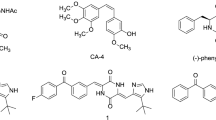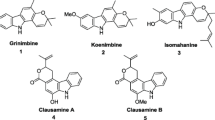Abstract
In a continuing effort to find new cytotoxic, antitumor, and less toxic agents from β-carbolines derivatives, using experimental and computational studies, five β-carboline alkaloids were tested in vitro for their cell growth inhibitory activity using Lepidium sativum phytotest. Then, molecular docking and correlation analysis between activity and structure study was performed to identify the interaction mode between these compounds and the colchicine binding site of tubulin. The experimental results revealed that harmaline and harmalol represent the most active compounds with IC50 of 134.15 μg/mL and 239.43 μg/mL, respectively, lower than colchicine which is 248 μg/mL. The correlation analysis between activity and structure indicates that the hydroxy group and the partial hydrogenation of the pyridyl ring increase activity. Indeed, molecular docking analysis revealed that harmaline and harmalol have low binding energy and could interact, in particular through conventional hydrogen bonds and van der Waals interactions with the colchicine binding site of tubulin, indicating that harmaline and harmalol could have an antimitotic effect. Moreover, in silico analysis of ADME/Tox properties reveals that these molecules possess promising pharmacokinetic properties in terms of intestinal adsorption, volume of distribution, blood-brain barrier permeability and toxicity. The results obtained were used to design new harmaline derivative molecule, with promising results after a preliminary in silico evaluation. In summary, our results indicate that the β-carboline alkaloids studied have an in vitro and in silico antimitotic activity and their pharmacokinetic properties are promising and should be confirmed by an in vivo study.




Similar content being viewed by others
References
Wark PA, Peto J (2017) Cancer epidemiology. International encyclopedia of public health. Elsevier, pp 339–346. https://doi.org/10.1016/B978-0-12-803678-5.00048-5
Ferlay J, Soerjomataram I, Dikshit R et al (2015) Cancer incidence and mortality worldwide: sources, methods and major patterns in GLOBOCAN 2012: Globocan 2012. Int J Cancer 136:E359–E386. https://doi.org/10.1002/ijc.29210
Parsa N (2012) Environmental factors inducing human cancers. Iran J Public Health 41:1–9
van Vuuren RJ, Visagie MH, Theron AE, Joubert AM (2015) Antimitotic drugs in the treatment of cancer. Cancer Chemother Pharmacol 76:1101–1112. https://doi.org/10.1007/s00280-015-2903-8
Moloudizargari M, Mikaili P, Aghajanshakeri S et al (2013) Pharmacological and therapeutic effects of Peganum harmala and its main alkaloids. Pharmacogn Rev 7:199. https://doi.org/10.4103/0973-7847.120524
de Frias UA, Mendes Costa MC, Takahashi JA et al (2012) Banisteriopsis species: a source of bioactive of potential medical application. IntJ Biotechnol Wellness Ind 1:163–171. https://doi.org/10.6000/1927-3037/2012.01.03.02
Machado MW, Stern Neto C, Salgado J et al (2010) Search for alkaloids on callus culture of Passiflora alata. Braz Arch Biol Technol 53:901–910. https://doi.org/10.1590/S1516-89132010000400020
Rashid MA, Gustafson KR, Boyd MR (2001) New cytotoxic N-methylated β-carboline alkaloids from the marine ascidian Eudistoma gilboverde. J Nat Prod 64:1454–1456
Chen Q, Chao R, Chen H et al (2005) Antitumor and neurotoxic effects of novel harmine derivatives and structure-activity relationship analysis. Int J Cancer 114:675–682. https://doi.org/10.1002/ijc.20703
Kumar S, Singh A, Kumar K, Kumar V (2017) Recent insights into synthetic β-carbolines with anti-cancer activities. Eur J Med Chem 142:48–73. https://doi.org/10.1016/j.ejmech.2017.05.059
Braestrup C, NIELSENt M, Olsen CE (1980) Urinary and brain f3-carboline-3-carboxylates as potent inhibitors of brain benzodiazepine receptors. Proc Natl Acad Sci U S A 77:2288–2292
Suzuki K, Nomura I, Ninomiya M et al (2018) Synthesis and antimicrobial activity of β-carboline derivatives with N2-alkyl modifications. Bioorg Med Chem Lett 28:2976–2978. https://doi.org/10.1016/j.bmcl.2018.06.050
Nazari Formagio AS, Santos PR, Zanoli K et al (2009) Synthesis and antiviral activity of β-carboline derivatives bearing a substituted carbohydrazide at C-3 against poliovirus and herpes simplex virus (HSV-1). Eur J Med Chem 44:4695–4701. https://doi.org/10.1016/j.ejmech.2009.07.005
Tonin LTD, Panice MR, Nakamura CV et al (2010) Antitrypanosomal and antileishmanial activities of novel N-alkyl-(1-phenylsubstituted-β-carboline)-3-carboxamides. Biomed Pharmacother 64:386–389. https://doi.org/10.1016/j.biopha.2010.02.006
Waki H, Park KW, Mitro N et al (2007) The small molecule harmine is an antidiabetic cell-type-specific regulator of PPARγ expression. Cell Metab 5:357–370. https://doi.org/10.1016/j.cmet.2007.03.010
Yamazaki Y, Kawano Y (2011) Inhibitory effects of herbal alkaloids on the tumor necrosis factor-a and nitric oxide production in lipopolysaccharide-stimulated RAW264 macrophages. Chem Pharm Bull 59:388–391
Sunder-Plassmann N, Sarli V, Gartner M et al (2005) Synthesis and biological evaluation of new tetrahydro-β-carbolines as inhibitors of the mitotic kinesin Eg5. Bioorg Med Chem 13:6094–6111. https://doi.org/10.1016/j.bmc.2005.06.027
Samundeeswari S, Kulkarni MV, Joshi SD et al (2016) Synthesis and human anticancer cell line studies on coumarin-β-carboline hybrids as possible antimitotic agents. ChemistrySelect 1:5019–5024. https://doi.org/10.1002/slct.201601020
Kamal A, Sathish M, Nayak VL et al (2015) Design and synthesis of dithiocarbamate linked β-carboline derivatives: DNA topoisomerase II inhibition with DNA binding and apoptosis inducing ability. Bioorg Med Chem 23:5511–5526. https://doi.org/10.1016/j.bmc.2015.07.037
Sobhani AM, Ebrahimi S-A, Mahmoudian M (2002) An in vitro evaluation of human DNA topoisomerase I inhibition by Peganum harmala L. seeds extract and its β-carboline alkaloids. J Pharm Pharmaceut Sci 5:19–23
Nafisi S, Bonsaii M, Maali P et al (2010) β-Carboline alkaloids bind DNA. J Photochem Photobiol B 100:84–91. https://doi.org/10.1016/j.jphotobiol.2010.05.005
Song Y, Wang J, Teng SF et al (2002) β-Carbolines as specific inhibitors of cyclin-dependent kinases. Bioorg Med Chem Lett 12:1129–1132
Zhang J, Li Y, Guo L et al (2009) DH166, a beta-carboline derivative, inhibits the kinase activity of PLK1. Cancer Biol Ther 8:2374–2383. https://doi.org/10.4161/cbt.8.24.10182
Zhao L, Wink M (2013) The β-carboline alkaloid harmine inhibits telomerase activity of MCF-7 cells by down-regulating hTERT mRNA expression accompanied by an accelerated senescent phenotype. Peer J 1:e174. https://doi.org/10.7717/peerj.174.
Costa RA, Oliveira KMT, de Cássia Saraiva Nunomura R et al (2018) Quantum chemical properties investigation and molecular docking analysis with DNA topoisomerase II of β-carboline indole alkaloids from Simaba guianensis: a combined experimental and theoretical DFT study. Struct Chem 29:299–314. https://doi.org/10.1007/s11224-017-1029-5
Cao R, Chen Q, Hou X et al (2004) Synthesis, acute toxicities, and antitumor effects of novel 9-substituted β-carboline derivatives. Bioorg Med Chem 12:4613–4623. https://doi.org/10.1016/j.bmc.2004.06.038
Lamchouri F, Settaf A, Cherrah Y et al (2000) In vitro cell-toxicity of Peganum harmala alkaloids on cancerous cell-lines. Fitoterapia 71:50–54. https://doi.org/10.1016/S0367-326X(99)00117-3
Lamchouri F, Settaf A, Cherrah Y et al (1999) Antitumour principles from Peganum harmala seeds. Therapie 54:753–758
Lamchouri F, Toufik H, Bouzzine SM et al (2010) Experimental and computational study of biological activities of alkaloids isolated from Peganum harmala seeds. J Mater Environ Sci 1:343–352
Lamchouri F, Zemzami M, Bouljihad M et al (2001) Modèles expérimentaux de cancers (in vitro et in vivo) de screening de nouveaux agents anticancéreux. Biol Santé 1:93–104
Lamchouri F, Zemzami M, Jossang A et al (2013) Cytotoxicity of alkaloids isolated from Peganum harmala seeds. Pak J Pharm Sci 26:699–706
Lamchouri F, Toufik H, Elmalki Z et al (2013) Quantitative structure–activity relationship of antitumor and neurotoxic β-carbolines alkaloids: nine harmine derivatives. Res Chem Intermed 39:2219–2236. https://doi.org/10.1007/s11164-012-0752-1
Akabli T, Toufik H, Yasri A et al (2018) Combining ligand-based and structure-based drug design approaches to study the structure-activity relationships of a β-carboline derivative series. Struct Chem 29:1637–1645. https://doi.org/10.1007/s11224-018-1141-1
Gagiu F, Nistor C, Danciu F et al (1973) Mito depressant substances a new bio test and its application to some alpha alkylphenyl acetic derivatives. Ann Pharm Fr 31:363–367
Morris GM, Huey R, Lindstrom W et al (2009) AutoDock4 and AutoDockTools4: automated docking with selective receptor flexibility. J Comput Chem 30:2785–2791
Ravi L, Kannabiran K (2016) A handbook on protein-ligand docking tool: Autodock4. Innovare J Med Sci 4:1–6
(2016) Dassault Systèmes BIOVIA, Discovery Studio Modeling Environment, Release 2017. Dassault Systèmes, San Diego. http://accelrys.com/products/collaborative-science/bioviadiscoverystudio/. Accessed 01 June 2018
DeLano WL (2008) The PyMOL Molecular Graphics System, Version 2.0 Schrödinger, LLC. http://www.pymol.org. Accessed 01 June 2018
Pires DEV, Blundell TL, Ascher DB (2015) pkCSM: predicting small-molecule pharmacokinetic and toxicity properties using graph-based signatures. J Med Chem 58:4066–4072. https://doi.org/10.1021/acs.jmedchem.5b00104
Lipinski CA, Lombardo F, Dominy BW, Feeney PJ (2001) Experimental and computational approaches to estimate solubility and permeability in drug discovery and development settings. Adv Drug Deliv Rev 46:3–26
Veber DF, Johnson SR, Cheng H-Y et al (2002) Molecular properties that influence the oral bioavailability of drug candidates. J Med Chem 45:2615–2623. https://doi.org/10.1021/jm020017n
Molecular Operating Environment software, Chemical Computing Group Inc., Montreal, Quebec, Canada. http://www.chemcomp.com/. Accessed 01 June 2018
Graphpad Prism version 7.0, GraphPad Software, Inc. California, USA. https://www.graphpad.com/. Accessed 26 May 2018
Tse SYH, Mak I-T, Dickens BF (1991) Antioxidative properties of harmane and β-carboline alkaloids. Biochem Pharmacol 42:459–464
Sarkar S, Bhattacharjee P, Bhadra K (2016) DNA binding and apoptotic induction ability of harmalol in HepG2: biophysical and biochemical approaches. Chem Biol Interact 258:142–152. https://doi.org/10.1016/j.cbi.2016.08.024
Bhattacharjee P, Sarkar S, Ghosh T, Bhadra K (2018) Therapeutic potential of harmaline, a novel alkaloid, against cervical cancer cells in vitro: apoptotic induction and DNA interaction study. J Appl Biol Biotechnol 6:1–8. https://doi.org/10.7324/JABB.2018.60401
Daina A, Michielin O, Zoete V (2017) SwissADME: a free web tool to evaluate pharmacokinetics, drug-likeness and medicinal chemistry friendliness of small molecules. Sci Rep 7:42717. https://doi.org/10.1038/srep42717
Author information
Authors and Affiliations
Corresponding author
Ethics declarations
Conflict of interests
The authors declare that they have no conflict of interest.
Ethical approval
This study does not contain any studies with human participants or animals performed by any of the authors.
Additional information
Publisher’s note
Springer Nature remains neutral with regard to jurisdictional claims in published maps and institutional affiliations.
Rights and permissions
About this article
Cite this article
Akabli, T., Lamchouri, F., Senhaji, S. et al. Molecular docking, ADME/Tox prediction, and in vitro study of the cell growth inhibitory activity of five β-carboline alkaloids. Struct Chem 30, 1495–1504 (2019). https://doi.org/10.1007/s11224-019-01308-x
Received:
Accepted:
Published:
Issue Date:
DOI: https://doi.org/10.1007/s11224-019-01308-x




